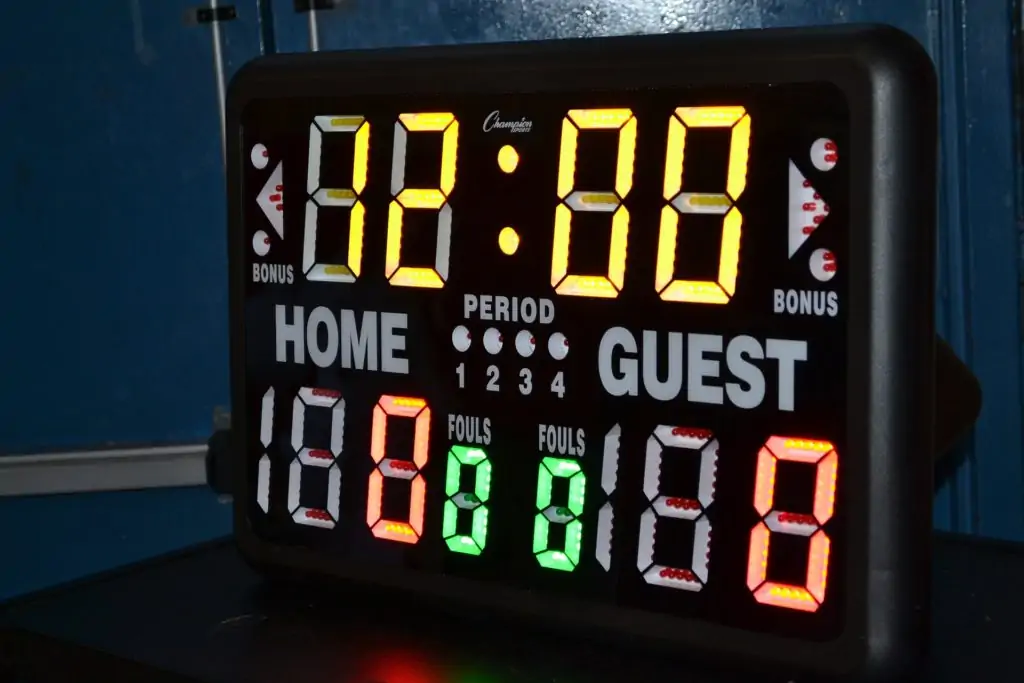Have you ever scoured a box score, noticed something in the far right column that says +/-, and wondered what it meant? Many have that similar experience. So, what does +/- mean in basketball?
Well, admittedly, basketball is a game measured by dozens of different stats. There are traditional stats, advanced stats, and tracking stats; and each of these can be broken into offensive or defensive statistics. Casual fans may know of traditional stats (points, rebounds, assists, steals, blocks, etc.) but the +/- often escapes notice. Again, what does plus/minus mean in basketball?
 What is +/- Stat in Basketball?
What is +/- Stat in Basketball?
The Box Plus/Minus or BPM (some simply call it PM) is a metric based on the box score to calculate a player’s contributions to the team’s overall score when he is on the court. It is exclusively based on the box score, and there is no way to tell the context of what a player did to have that contribution. While individual players have a different +/- rating, the stat is influenced by the whole team, and how the team performs offensively and defensively.
The +/- statistic did not begin in basketball but rather in hockey. In that sport, it is called goal differential. The stat was pioneered by the Montreal Canadiens of the NFL in the 50s and teams followed suit after that. In 1967-1968, the NHL officially kept tracking of the +/- stat.
In the NBA, it was in the 2007-08 season when plus/minus was officially shown in the box score although it was already tracked by 1973. Using the +/- stat, it can also be determined what the best three, four, or five-man lineups are for every team.
Coming from the simple BPM stat, basketball statheads have come up with other +/- metrics such as the DPM (Defensive Plus/Minus), ADM (Adjusted Plus/Minus), RPM (Real Plus/Minus) and more. For the sake of this article, let us just talk about the basic definition of the +/- stat.
 How is Plus/Minus Determined in Basketball and in the NBA?
How is Plus/Minus Determined in Basketball and in the NBA?
The Plus/Minus determines how well the team performs when an individual player is on the court. It is determined by calculating the difference in the score when the player enters the game and when he comes out. Since players freely come in and out of the game, all of the differences during the period are added over the entirety of the game. The result is the Plus/Minus stats of a player in the entire game.
Not clear enough? OK, we are going to give you an example: Let’s say the Lakers and the Bucks are playing. Now, all players are assumed to have a starting plus/minus of zero. First offensive play of the game, Giannis Antetokounmpo drives, meets a double team and kicks it to an open Khris Middleton in the corner who makes the three. The score is now 3-0. That means, all five Bucks on the floor have a plus-minus of +3; conversely, all Lakers players have a +/- of -3.
Now, it’s Lakers ball. LeBron James runs pick and roll with Anthony Davis; AD slips the screen and LeBron threw the lob for an easy score. It’s the Bucks leading, 3-2. That means all five Milwaukee players on the floor have a plus/minus of +1. All who wear purple and gold during this time have a plus/minus of -1. And it rolls from there.
When a player is subbed out, his plus/minus rating stops and continues when he is subbed in again. So when you see, say, Alex Caruso with a plus/minus of +8 at the end of the game, that means the Lakers have outscored their opponents by eight points when Caruso is on the floor.

 How Does +/- Evaluate Players?
How Does +/- Evaluate Players?
We have to admit that, while +/- is not a perfect stat, it provides a simple way to evaluate players. In fact, when the plus/minus is officially included in the NBA box scores, it highlights the importance of role players like Shane Battier. Battier may not score much, but his team often outscores opponents when he is on the floor. So, how does plus/minus evaluate players?
In basketball, a player may score 20 points a night, but that does not tell the whole story. If he plays terrible defense, always missing assignments and rotations, the 20 PPG scorer could easily give up as much or even more than the 20 he’s contributing! If that’s the case, then that particular 20 PPG scorer is a net negative. Straightforwardly, the +/- exposes “empty stats.”
Let’s take, for example, Devin Booker. Booker is one of the NBA’s best young scorers, no doubt about that, but on occasion, he puts up empty stats. In the January 1, 2020 game against the Lakers, Booker had 32 points and seven assists, shooting a decent 47% from the floor and 90% from the line (9-for-10). That’s good, right? Not so fast! The +/- revealed that the Suns were outscored by 13 points in the 37 minutes Booker was on the floor.
Now, let’s go back to Shane Battier. In Game 2 of the Eastern Conference semifinals in 2013 against Chicago, Battier had 3 points, 1 rebound, 1 assist, and a steal for the Miami Heat. What a scrub, right? Wrong.
A closer look reveals that the Heat outscored the Bulls by 42 points in the 22 minutes that Battier was on the floor. Miami ended up blowing out Chicago, 115-78. While Battier may just have scored on one basket, it shows that the Heat’s massacre of the Bulls was done when Battier was playing. It would not be an exaggeration to point out that Battier made the whole thing click.
From these examples, the plus/minus stat reveals not scorers but contributors. It shows impact (and non-impact) players, ones that contribute directly to the team’s performance on the court (and the ones that hurt you). That is why coaches love pointing at the +/- stat in their evaluation of which players have a positive impact when given playing time.
Of course, there are also limitations to the +/- stat. It may be true that the Suns were -13 when Booker was on the floor, but that should also put the responsibility on the players with him for those 37 minutes. Battier’s +/- was off the charts, but he was on the floor with some combination of Dwyane Wade, Chris Bosh, and LeBron James, who all had plus/minuses of +31, +26 and +25, respectively.
What does that all say? You can’t always point one finger on the guy who had the highest +/-. In this case, Battier made a tremendous impact, but he was part of a lineup that played well overall. So, one use of the +/- stat is to find effective lineups, one that meshes and plays well together. Needless to say, everything, including the plus/minus statistic, should be taken into the proper context.
 What is a Good +/- Stat?
What is a Good +/- Stat?
The league average is at 0.0 by default. However, it is noted that more players are below-average than above-average, mainly because of playing time. If a player gets meaningful playing time, his +/- is expected to go up.
Generally, a plus/minus of +5 can already be seen as an All-Star level player. Anything above that, we’re looking at a Hall of Fame shoo-in. Anyone who does below +5 but still at a positive rate can be a starter in the league, while players who net a negative plus/minus are replacement level bench players at best. If you do want to have an impact on your team, make sure your plus/minus is at the positive, because you can bet on it, your coach knows about that.
 Who Had the Highest Plus/Minus in NBA History?
Who Had the Highest Plus/Minus in NBA History?
Before we go into the highest plus/minus in the history of the NBA, let’s have some random +/- notes first:
- The highest +/- recorded in an NBA game happened on Nov. 22, 2017, when Luc Richard Mbah a Moute had a +57 for Houston against the Denver Nuggets. He had 13 points, four rebounds, and four steals to lead the 125-95 rout.
- The second-highest plus/minus is +52 by Joe Smith. This took place on Nov. 8, 2001, against the Chicago Bulls when Smith was playing for the Minnesota Timberwolves.
- The owner of the highest +/- recorded throughout the season was Draymond Green. This happened in 2015-16, Golden State’sState’s 73-win season. Green had a season total of +1073 or +18.34 per 48 minutes of playing time.
- While Green had the highest total +/- in a season, his teammate, two-time MVP Steph Curry has the highest +/- per 48 minutes throughout the season. In 2016-17, Curry averaged a +18.47 per 48 minutes of play and a total of +1,015 for the season. The perceivable difference is Curry played 76 games in 2016-17 while Green played 81 games in 2015-16.
- Speaking of Steph Curry, he owns three of the five highest +/- seasons in the NBA. The others in the top 5 are Draymond Green’s 2015-16 season (number 1) and Michael Jordan’s 1995-96 season (number four).
Highest Plus/Minus in NBA History (All-time):
| Player | Plus/Minus |
| Michael Jordan | 9.22 |
| LeBron James | 8.94 |
| Chris Paul | 7.59 |
| Magic Johnson | 7.54 |
| David Robinson | 7.48 |
| Larry Bird | 6.89 |
| James Harden | 6.88 |
| John Stockton | 6.83 |
| Kawhi Leonard | 6.81 |
| Kevin Durant | 6.74 |
Highest Plus/Minus in NBA History (Total for a single season):
| Player | Year | Plus/Minus |
| Draymond Green | 2015-16 | +1073 |
| Steph Curry | 2015-16 | +1023 |
| Steph Curry | 2016-17 | +1015 |
| Michael Jordan | 1995-96 | +980 |
| Steph Curry | 2014-15 | +920 |
| Scottie Pippen | 1995-96 | +899 |
| LeBron James | 2008-09 | +871 |
| Draymond Green | 2014-15 | +839 |
| Klay Thompson | 2015-16 | +836 |
| Draymond Green | 2016-17 | +820 |
As you can see, half of the all-time plus/minus leaders are already in the Hall of Fame. And it’s safe to say that it’s only a matter of time before all of the other five will be there as well. And while we can readily see that the best players are typically the leaders in plus/minus, it’s worthy to note that the single-season leaders point out to its limitations as well.
How? Take a closer look: Draymond Green has three of the ten highest +/- totals for a single season. But, he also happens to play with Steph Curry and Klay Thompson in all of those seasons. We’re not saying Green is not great, but rather than showing how good one player is, the +/- statistic often reveals the best line-ups for a team. In this case, Green, Curry, and Thompson are playing heavy minutes while working exceptionally well together; hence, they all have historically high +/- ratings.
Wrapping Things Up: Plus/Minus in Basketball
From a coach’s perspective, you need to look way beyond the points, rebounds, and assists to tell you who’s making a positive impact and who’s not. The simplest way to do it without doing complicated formulas, algorithms, and whatnot is the plus/minus.
What, again, is the plus/minus statistic? It is a simple calculation of a player’s contribution to the team’s overall score when he is on the floor. While +/- is an individual stat, meaning different players have different plus/minus ratings, it is actually a good indication of how well a lineup plays together. What’s more is that it also reveals what we call “empty stats,” stats that look good on paper, but the player contributing those are actually a detriment to the overall score of the team.
A given example of the latter was that of Devin Booker. There was a game where he scored 30 plus on New Year’s day against the Lakers, but the Suns lost by 10. If you look at Booker’s +/-, Phoenix was outscored by 13 in the time he was on the floor. Of course, like we said, who he’s with in the lineup matters. However, it also exposed a hole in Booker’s overall statistics.
Talking about positive impact, naturally, a player with a positive +/- is an asset to the team. Anything above +5 is worthy of a star or superstar status, and anything in the +1 to +3 is starter level. A -1 to -3 rating is usually for replacement level bench players; anything below that is fit for guys at the end of the bench.
As we all can see, the guys who had the highest plus-minus in NBA history are also some of the best to ever play the game. Many of those names are icons– Michael Jordan, Magic Johnson, and Larry Bird. LeBron James, James Harden, Kawhi Leonard, and Kevin Durant are probably on their way, if not, are there already. That just goes to show the accuracy of the +/- statistic on highlighting impact players, although it does have its limitations as well.
So, is plus-minus a good stat for the NBA? We think it is. It is a simple way for coaches to know who is making an impact on the game. Instead of an individual statistic, though, we think it should be viewed in the context of lineups. It would be wrong to conclude that Player A with the +30 rating did all the hard work for the team. Regardless, for a casual fan to get to the next level of fandom, we recommend for them to know the answer to the question: “What does plus/minus mean in basketball?”
If you found this post helpful, you’re definitely going to like our other FAQ articles here.
More engaging basketball FAQ posts here:
> What is a Double Double in Basketball?
> What is a Triple Double in Basketball?
> What Does PPG Mean in Basketball?
Want to get better at basketball?
Join our newsletter & get our comprehensive
101-page basketball guide.
Become a better baller today 👇


 What is +/- Stat in Basketball?
What is +/- Stat in Basketball?  How is Plus/Minus Determined in Basketball and in the NBA?
How is Plus/Minus Determined in Basketball and in the NBA?
 How Does +/- Evaluate Players?
How Does +/- Evaluate Players?  What is a Good +/- Stat?
What is a Good +/- Stat?
 Who Had the Highest Plus/Minus in NBA History?
Who Had the Highest Plus/Minus in NBA History? 


